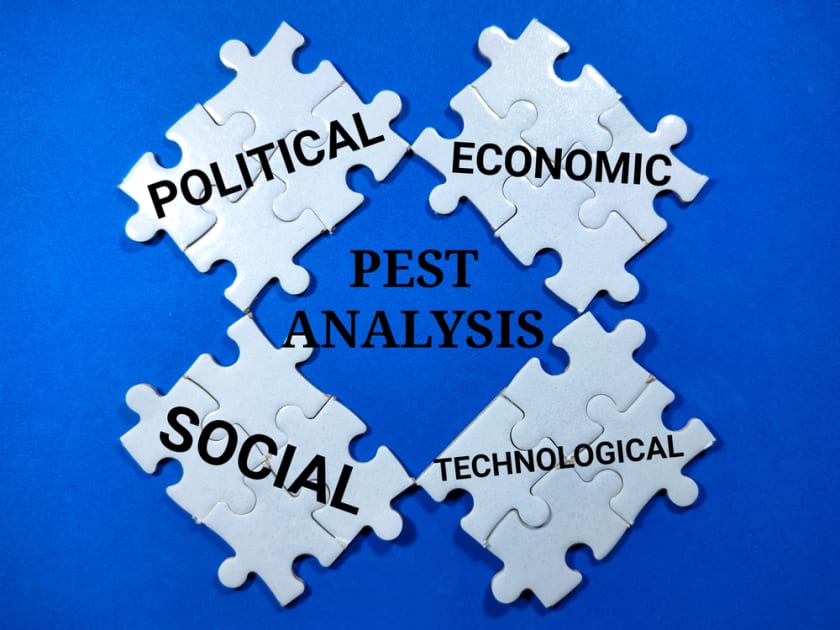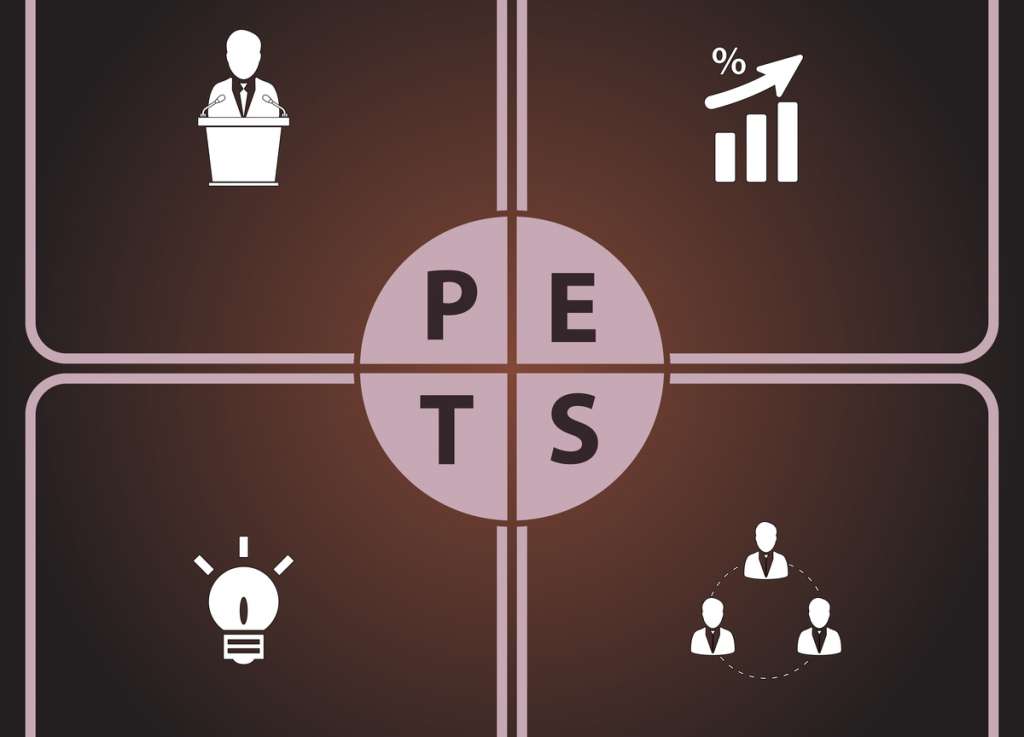The How and What of PEST Analysis for Apparel and Retail Brands



The fashion business emerged during the mid-nineteenth century. However, in the past few decades, it has matured into a fully grown-up multinational business in which designers design clothing in one country, produce them in another, and brands sell them in many markets across the globe.
What exactly is a PEST analysis?
The PEST analysis is a valuable method or framework for assessing and monitoring market growth or fall, as well as a business's position, potential, and direction. It evaluates the external environment, political, economic, social, and technological factors. It is often broadened to incorporate legal and environmental aspects and is referred to as a PESTLE analysis.
How to conduct a PEST analysis
To do a PEST analysis, we must consider a few things:
- Do your internal study to find out what kinds of laws or rules are applicable to you.
- Identify which market factors will have an influence on your firm and conduct online research to see where these factors are now and where prominent economists believe they will be in the future. Consult with your internal management to see if they are experiencing or anticipate any problems in their respective areas.
- Read industry magazines, which typically emphasise societal concerns that affect the whole sector.
- Speak to your customer care and sales employees to find out why consumers purchase and why they return or reject.
- If you own a local firm, undertake an area market study regularly to better understand your prospective clients.
- Keep up to date on new technology and creative ways to use it to create goods and services in your sector.
- Examine the biggest developing technologies, such as electric vehicles, artificial intelligence, and virtual and augmented reality, to see how they might help or hinder your organisation.
Factors that influence apparel and retail brands

The conventional textile sector has gone through many stages of change. From traditional shopping to e-commerce, and from e-commerce to social media platforms and digital stores - the apparel market has experienced substantial transition over the last decade and continues to develop at a rapid pace. This PEST analysis of the apparel and retail brands delves deeply into the several aspects that drive fashion as we currently know it.
Political factors
When it comes to apparel or fashion accessories, there are almost limitless possibilities available nowadays. This is why clothing brands must be on their toes and attract the customers' attention at all times since this is what will lead to the company's future.
A conducive political environment is therefore essential for a firm to function smoothly and effectively in any location.
Workers at textile manufacturing factories may protest against their employers, particularly if their pay or medical benefits are lower than those in similar sectors. This might lead retail brands to be late in receiving spring or autumn trends.
Non-employee activists may protest against businesses that buy apparel from countries known to violate child labour regulations. This unfavourable publicity may influence the sales and earnings of retail brands.
An election influencing import/export policy, as well as commodity taxes, might be political considerations impacting the textile sector. Aside from political stability, other variables such as a country's governing party changing, government legislation changing, prior political upheaval, and so on may have an impact on the company's political atmosphere.
Economic factors
Economic factors have a significant influence on the apparel and retail industries. They may have an impact on the apparel business in both good and bad ways. While it accounts for a significant portion of the global economy, it is influenced by global economic changes. Economic instability may have an impact on sales and earnings.
The fashion business has a positive impact on the economy since it is a major employer. In this sense, the fashion industry both influences and is influenced by economic issues. The willingness of a country's population to spend its money is determined by its economic growth and development.
The purchasing power of consumers has grown, which is excellent news. People have greater spare money to purchase more apparel during economic boom eras. Clothing makers, distributors, and retailers benefit from increased sales. Recessions, on the other hand, have the opposite impact. Sales for these diverse apparel companies may be much lower.
As a result, businesses may find themselves with a significant volume of inventory. Furthermore, they may be forced to sell the clothes at significantly discounted costs. To compete with more generic brands, apparel makers and merchants may need to offer lower-priced clothing labels. When consumers have less spare cash, they often go for lower-priced products.
Additional elements that may have an impact on the company's economic environment include a country's GDP, interest rates, tax rates, inflation and employment rates. Other economic issues, such as trade restrictions and exchange rates, might have a significant influence on sales and hence the company's profitability and growth.
Social factors
Socio-cultural issues also have a serious influence on the expansion of apparel and retail brands. In the previous 10 years, there have been significant societal developments that have influenced the market for fashion items.
Although the millennial generation has become the primary target of fashion marketers, their tastes vary greatly from prior generations. A lot of socio-cultural developments have influenced how individuals shop and make purchasing choices, as well as which brands they prefer to buy from. Millennials are not only concerned with convenience but are also concerned with affordable pricing and high-quality products.
The apparel brands have felt the pressure, as seen by the emergence of fast fashion. PEST analysis example of fast fashion firm such as Zara has provided shoppers with inexpensive yet high-quality clothing. High-end fashion is no longer a luxury reserved for the wealthy since it has been made cheaper via the use of technology and innovative processes.
Even though the fabric quality is not as high as that of luxury labels, it is adequate, and in terms of style and design, these fashion retailers are not far behind. As a consequence, shoppers are flocking to quick fashion outlets. Not only have customers' tastes evolved, but so have other aspects of their lives. They have become more discriminating, making judgments based on information obtained quickly from a variety of sources.
Cultures, conventions, lifestyles, demography, and population changes are all social elements that influence fashion. As a PEST analysis example, a small garment maker must design patterns that appeal to people of diverse cultures, particularly if those ethnic groups account for a significant portion of its market.
The aesthetic and design-oriented culture and legacy of the nation that the firm is providing also have a significant effect in selecting the style of clothing that people choose. A tranquil social climate with active cultural events, as well as a country's degree of tourism, might be some of the social macroeconomic elements that influence demand for the company's goods.
Technological factors
Technological advancements are having a greater impact on customer preferences than ever before. Additionally, the industry's high-fashion category has had greater growth, which may be attributed in part to the availability of more cheap luxury brands in the segment. Those firms that provide high-quality fashion goods at reasonable rates have gained popularity among consumers.
Every firm in the fashion industry must take into consideration the need of adapting to environmentally friendly technical techniques in its sales and production operations. Aside from the highest level of inventiveness shown by its designers, the combination of mechanisation and craftsmanship plays an important role.
For a large number of individuals, online shopping is a dream come true. Instead of wading through crowded stores and physically searching for clothing you may like, you can browse through an online category, choose the size you want, and have it delivered in a matter of days. Globalisation, information technology, the internet, and the rising usage of mobile devices for shopping are all having an impact on sales, marketing, and customer decisions.
Consumers nowadays make decisions after thoroughly examining all options. They share their options with the other youngsters and also express their opinions on the issue.
Technology has disrupted several industries, and in addition to improving manufacturing and supply chain efficiency, it has also increased the efficacy of sales and marketing campaigns for fashion items. Another area in which technology has aided fashion firms is in their efforts to expand their operations internationally.
Ecommerce has enabled them to expand their reach across national lines and sell to a wider range of customers. Technology is not only assisting customers in obtaining the fashion they want, but it is also motivating designers to adorn the globe with innovative creations.
The logistics system that the firm employs must be well-designed and tailored to the specific needs of the organisation. Measures should be put in place so that invoicing, delivery, and change requests can all be completed in less time. These might be accomplished using the assistance of the most up-to-date technology.
Conclusion
We can't ignore the reality that the fashion business contributes significantly to the development of culture, trends, societies, and national economies around the world. With time, the industry develops more quickly than many others. Likewise, the competition is a challenge.
As a result, market participants must evaluate their company's success on a regular basis. And make any necessary adjustments to the approach. Before joining any new market, thoroughly assess all of the risks involved and make educated judgments.
To learn more about how to enhance your fashion brand and updates from the world of fashion, connect with Fashinza.



















